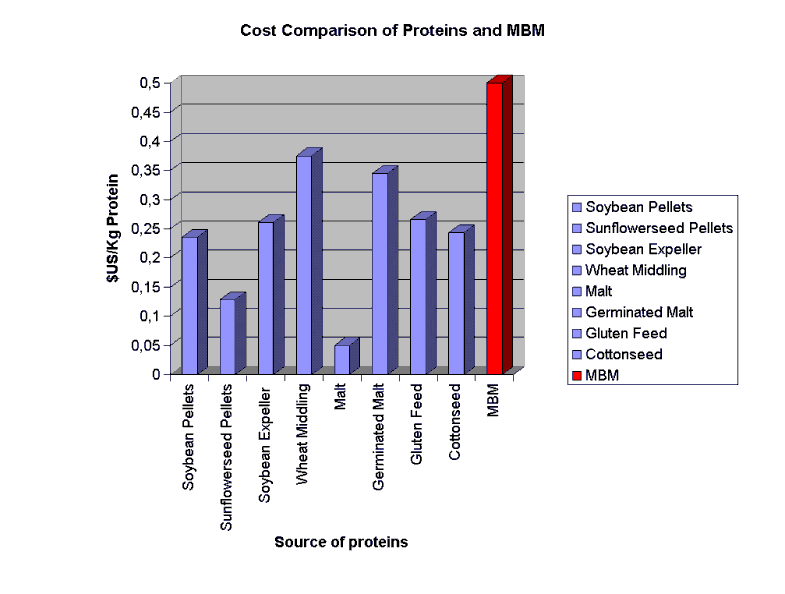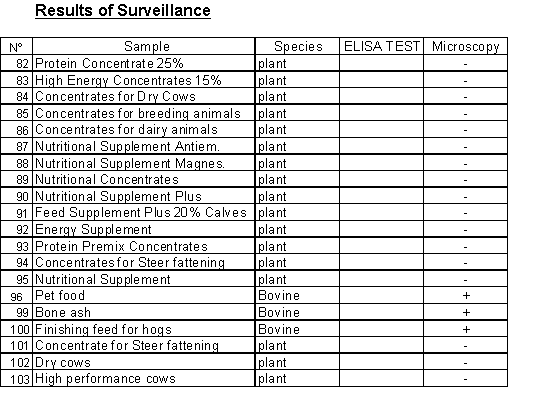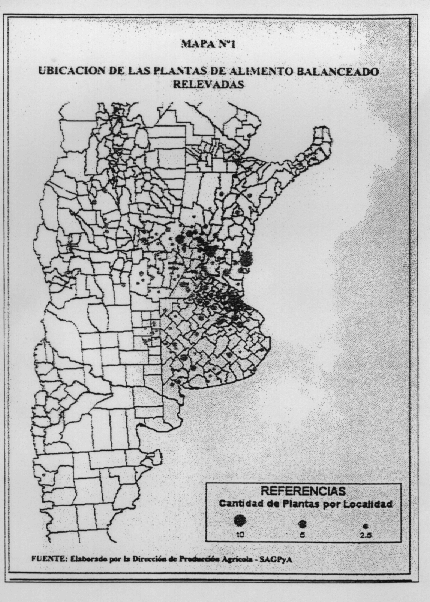
PROFILE OF THE BALANCED FEED INDUSTRY AND PERTINENT CONTROLS
Dr. F.G. Kyburg
IICA – SENASA - School of Veterinary Sciences, University of Buenos Aires, Argentina
Lic. Adriana Pazos
INTA Foodstuffs Institute, Argentina
Introduction
Livestock production in Argentina is extensive. Year-round grazing is the only feeding scheme as this source of food is abundant and low cost, in economic terms.
The genetic origin of Argentine cattle and sheep is European. Animal productivity relies on the quality and availability of pastures in the different regions (e.g.: average weight gain/year in the humid pampa area is 110/120 Kg/Ha/Year). The average weight of Argentine bovine carcasses is 201 Kg. The goal of the beef cattle industry in Argentina is to produce high quality beef with low cost production systems. As a result, feed supplementation is not common, except in specific and very few cases. The same characteristics, but to a greater degree apply to sheep production, although sheep are only grass fed.
Pastures are the only source of food for dairy cows. Milk production in Argentina clearly reflects this situation (2500 lt./cow/year).
Concentrated feed
TABLE 1 shows the evolution of the number of feed mills, which has increased continuously during the 1991 - 1998 period. Concentrates are used to feed beef cattle, dairy cows, broilers, poultry, hogs, pets and other animals.
The feed mills could be classified as follows:
TABLE 2 (Map) shows the geographic location of the mills in Argentina. Most of them are located in urban areas of the grain belt, and process the feed required by the local livestock population.
Feed mill output increased continuously in the 1991 - 1998 period (TABLE 3). The same type of feed has always been used for the same species (TABLE 4). The main feed producing areas, in decreasing order of importance are: Buenos Aires, Entre Ríos, Santa Fe and Córdoba.
TABLE 5 and 6 show the cost of different animal and plant proteins. The cost of producing meat and bone meal with 60 - 65% protein content, is 25% higher than wheat middling. As this ratio has remained almost constant for many years, only plant proteins are used to manufacture ruminant feed. TABLE 7 shows a comparison between the cost of the protein required to produce 1 Kg. of beef in a 400 Kg. steer, and live weight prices (1991 - 1998 average).
Economic parameters for poultry and hog production in Argentina are significantly different because most of the systems are intensive and therefore the use of proteins is more efficient. As a result, most of the meat and bone meal produced for domestic consumption (118,614 tonnes) is used as feed for hogs, poultry and pets (TABLE 8).
Bone ash is the only input of animal origin in bovine feed (SENASA Resolution 611/96). When used in the diet as a source of phosphorous, it is added in an amount equivalent to 0.55%. The usual source of calcium is crushed shells, as Argentina has large reserves of this material. Treatment of bone ash >600°C for 60 minutes guarantees destruction of the BSE agent and its transmission in the feed.
As of 1997, a surveillance program for feed mills has been implemented, to identify the presence of ruminant proteins in ruminant feed. (Res. 611/96).
To date, 102 samples have been tested with different diagnostic methods, including light microscopy and ELISA. No positive test results identifying Meat and Bone Meal in ruminant feed have been found.
References
INDEC, Vol. 14, 1998
SENASA - Yearbook 1998
SAGPyA - Concentrates, Working Document No. 8
FCV - UBA - Chair on Nutrition













